service CITROEN C1 2018 Owners Manual
[x] Cancel search | Manufacturer: CITROEN, Model Year: 2018, Model line: C1, Model: CITROEN C1 2018Pages: 269, PDF Size: 7.63 MB
Page 2 of 269
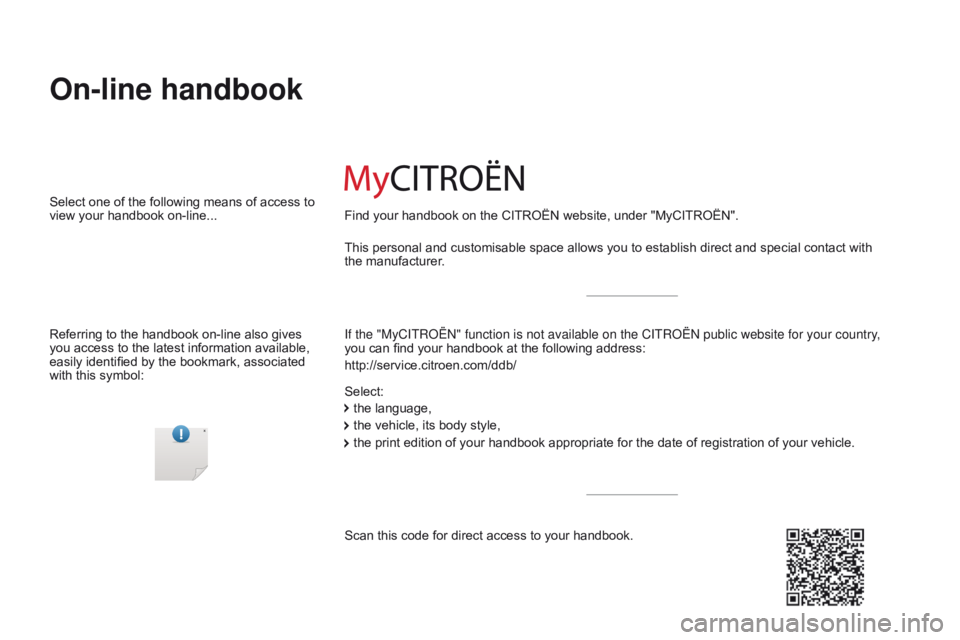
On-line handbook
If the "MyCITROĂ‹N" function is not available on the CITROĂ‹N public\
website for your country,
you can find  your  handbook  at  the  following  address:
http://service.citroen.com/ddb/ Find  your  handbook  on  the  CITROËN  website,  under  "MyCITROËN".
Select:
Select
Â
one
Â
of
Â
the
Â
following
Â
means
Â
of
Â
access
Â
to
Â
view
Â
your
Â
handbook
Â
on-line...
This personal  and  customisable  space  allows  you  to  establish  direct  and  special  contact  with Â
the manufacturer
.
the  language,
the
 vehicle,  its  body  style,
the
 print  edition  of  your  handbook  appropriate  for  the  date  of  registration  of  your  vehicle.
Scan
 this  code  for  direct  access  to  your  handbook.
Referring
Â
to
Â
the
Â
handbook
Â
on-line
Â
also
Â
gives
 you
Â
access
Â
to
Â
the
Â
latest
Â
information
Â
available,
Â
easily
Â
identified
Â
by
Â
the
Â
bookmark,
Â
associated
Â
with
Â
this
Â
symbol:
Page 12 of 269
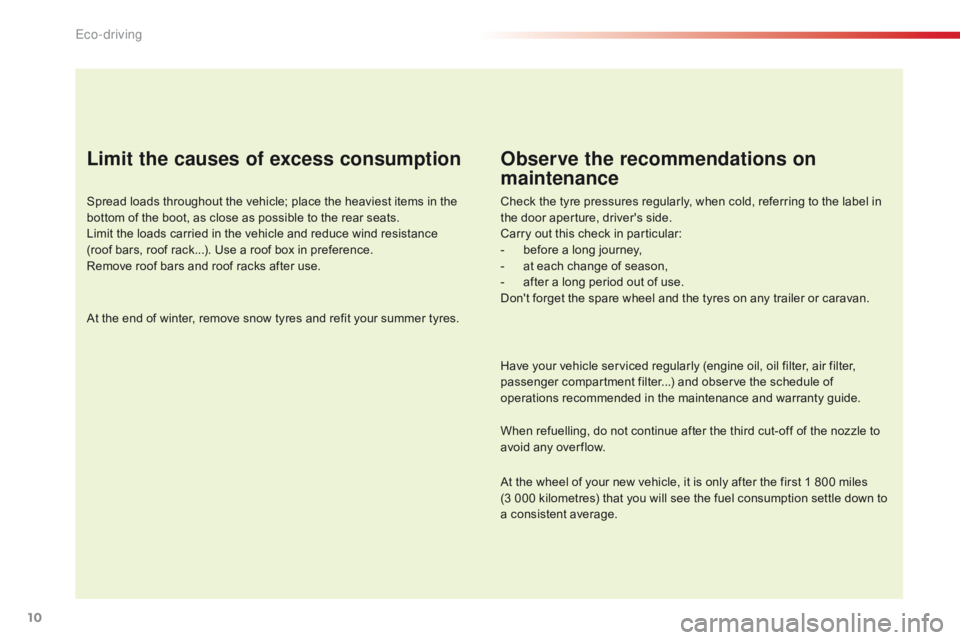
10
C1_en_Chap00c_eco-conduite_ed01-2016
Limit the causes of excess consumption
Spread loads throughout the vehicle; place the heaviest items in the bottom  of  the  boot,  as  close  as  possible  to  the  rear  seats.
Limit
 the  loads  carried  in  the  vehicle  and  reduce  wind  resistance Â
(roof
 bars,  roof  rack...).  Use  a  roof  box  in  preference.
Remove
 roof  bars  and  roof  racks  after  use.
At
 the  end  of  winter,  remove  snow  tyres  and  refit  your  summer  tyres.
Observe the recommendations on
maintenance
Check the tyre pressures regularly, when cold, referring to the label in the  door  aperture,  driver's  side.
Carry
 out  this  check  in  particular:
-
Â
b
efore  a  long  journey,
-
Â
a
t  each  change  of  season,
-
Â
a
fter  a  long  period  out  of  use.
Don't
 forget  the  spare  wheel  and  the  tyres  on  any  trailer  or  caravan.
Have
 your  vehicle  serviced  regularly  (engine  oil,  oil  filter,  air  filter, Â
p
assenger  compartment  filter...)  and  observe  the  schedule  of Â
o
perations  recommended  in  the  maintenance  and  warranty  guide.
When
 refuelling,  do  not  continue  after  the  third  cut-off  of  the  nozzle  to Â
a
void  any  over flow.
At
 the  wheel  of  your  new  vehicle,  it  is  only  after  the  first  1  800  miles Â
(
3 000  kilometres)  that  you  will  see  the  fuel  consumption  settle  down  to Â
a
 consistent  average.
Eco-driving
Page 39 of 269
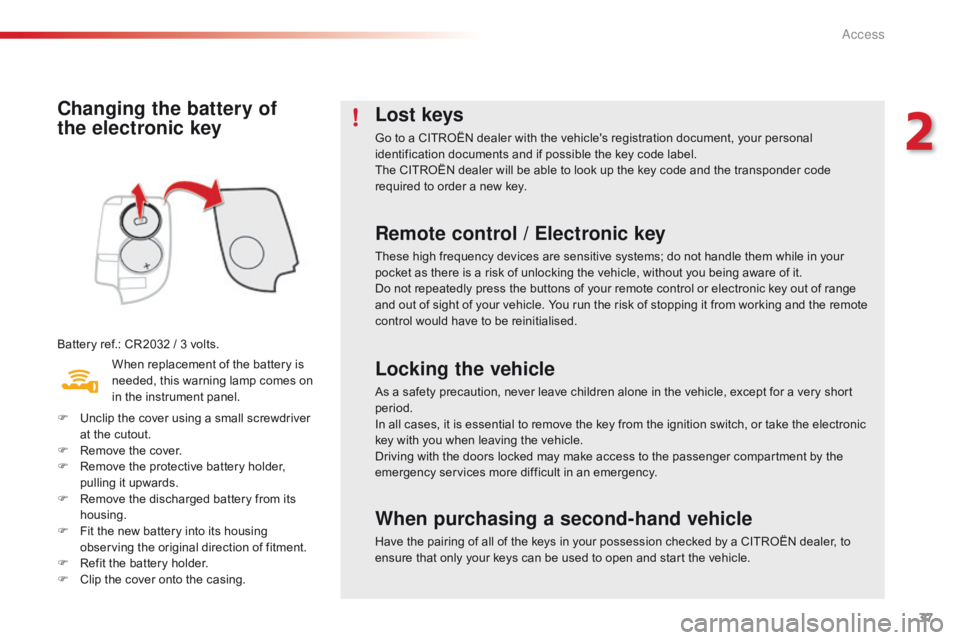
37
C1_en_Chap02_ouvertures_ed01-2016
Changing the battery of
the electronic key
Battery ref.: CR2032 / 3 volts.
W hen  replacement  of  the  battery  is Â
n
eeded,  this  warning  lamp  comes  on Â
i
n  the  instrument  panel.
F
Â
U
nclip  the  cover  using  a  small  screwdriver Â
a
t  the  cutout.
F
Â
R
emove  the  cover.
F
Â
R
emove  the  protective  battery  holder, Â
p
ulling  it  upwards.
F
Â
R
emove  the  discharged  battery  from  its Â
h
ousing.
F
Â
F
it  the  new  battery  into  its  housing Â
o
bserving  the  original  direction  of  fitment.
F
Â
R
efit  the  battery  holder.
F
Â
C
lip  the  cover  onto  the  casing.
Lost keys
Go to a CITROËN dealer with the vehicle's registration document, your personal identification  documents  and  if  possible  the  key  code  label.
The
 CITROĂ‹N  dealer  will  be  able  to  look  up  the  key  code  and  the  transponder  code Â
r
equired  to  order  a  new  key.
Remote control / Electronic key
These high frequency devices are sensitive systems; do not handle them while in your pocket  as  there  is  a  risk  of  unlocking  the  vehicle,  without  you  being  aware  of  it.
Do
 not  repeatedly  press  the  buttons  of  your  remote  control  or  electronic  key  out  of  range Â
a
nd  out  of  sight  of  your  vehicle.  You  run  the  risk  of  stopping  it  from  working  and  the  remote Â
c
ontrol  would  have  to  be  reinitialised.
Locking the vehicle
As a safety precaution, never leave children alone in the vehicle, except for a very short period.
In
 all  cases,  it  is  essential  to  remove  the  key  from  the  ignition  switch,  or  take  the  electronic Â
k
ey  with  you  when  leaving  the  vehicle.
When purchasing a second-hand vehicle
Have the pairing of all of the keys in your possession checked by a CITROËN dealer, to ensure  that  only  your  keys  can  be  used  to  open  and  start  the  vehicle.
Driving
 with  the  doors  locked  may  make  access  to  the  passenger  compartment  by  the Â
e
mergency  services  more  difficult  in  an  emergency.
2
Access
Page 147 of 269
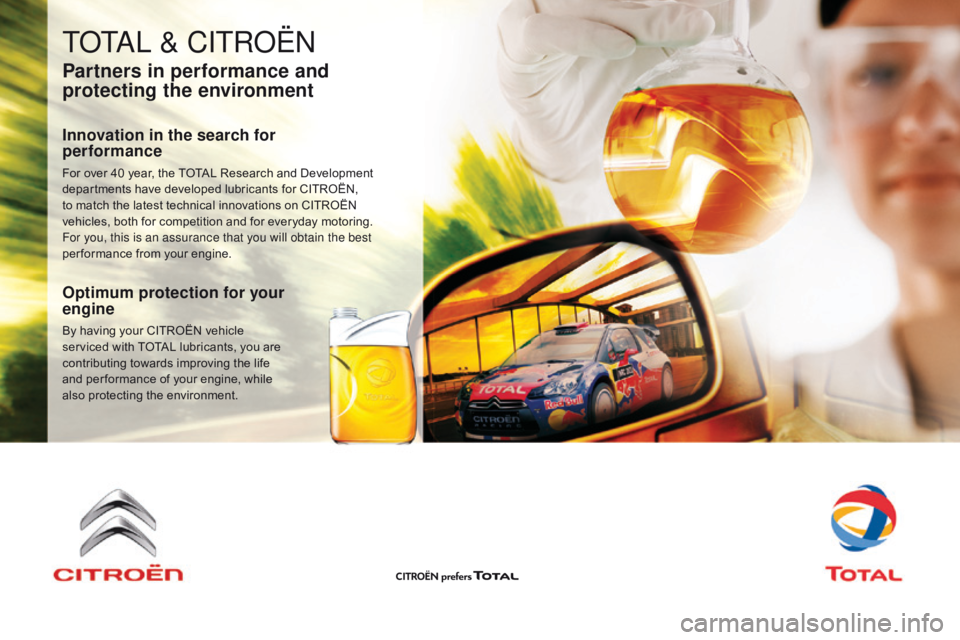
C1_en_Chap07_info-pratiques_ed01-2016
TOTAL & CITROĂ‹N
Partners in performance and
protecting the environment
Innovation in the search for
performance
For over 40 year, the TOTAL Research and Development departments  have  developed  lubricants  for  CITROĂ‹N, Â
t
o  match  the  latest  technical  innovations  on  CITROĂ‹N Â
v
ehicles,  both  for  competition  and  for  everyday  motoring.
For you, this is an assurance that you will obtain the best
per formance
 from  your  engine.
Optimum protection for your
engine
By having your CITROĂ‹N vehicle serviced  with  TOTAL  lubricants,  you  are Â
c
ontributing  towards  improving  the  life Â
a
nd  per formance  of  your  engine,  while Â
a
lso  protecting  the  environment.
Page 150 of 269
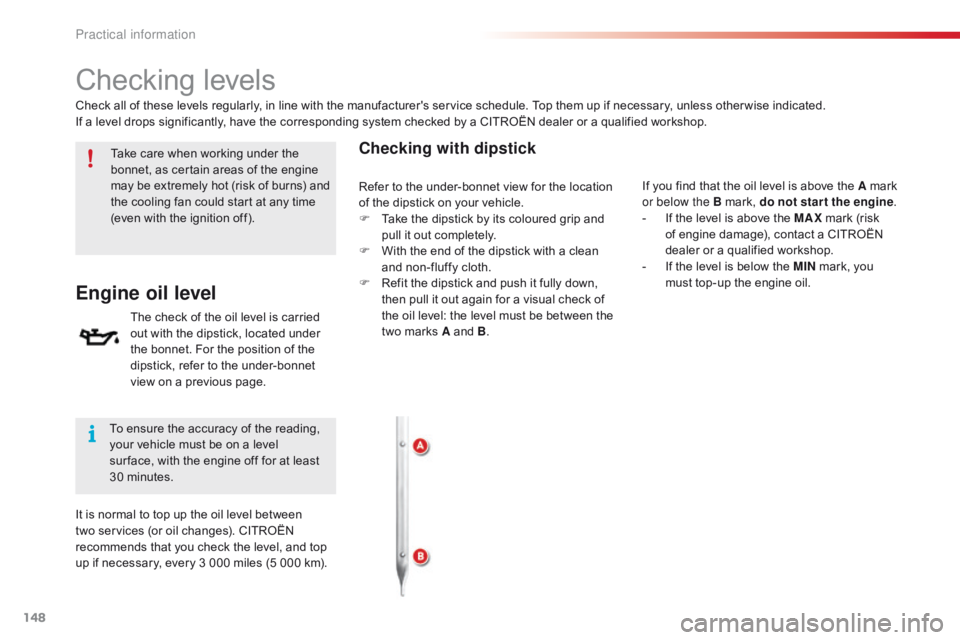
148
C1_en_Chap07_info-pratiques_ed01-2016
Checking levels
Take care when working under the bonnet,  as  certain  areas  of  the  engine Â
m
ay  be  extremely  hot  (risk  of  burns)  and Â
t
he  cooling  fan  could  start  at  any  time Â
(
even  with  the  ignition  off).
Engine oil level
The check of the oil level is carried out  with  the  dipstick,  located  under Â
t
he  bonnet.  For  the  position  of  the Â
d
ipstick,  refer  to  the  under-bonnet Â
v
iew  on  a  previous  page.
Checking with dipstick
Check all of these levels regularly, in line with the manufacturer's service schedule. Top them up if necessary, unless other wise indicated.
I f  a  level  drops  significantly,  have  the  corresponding  system  checked  by  a  CITROËN  dealer  or  a  qualified  workshop.
To
 ensure  the  accuracy  of  the  reading, Â
y
our  vehicle  must  be  on  a  level Â
s
ur face,  with  the  engine  off  for  at  least Â
3
0Â minutes.
It
 is  normal  to  top  up  the  oil  level  between Â
t
wo  services  (or  oil  changes).  CITROĂ‹N Â
r
ecommends  that  you  check  the  level,  and  top Â
u
p  if  necessary,  every  3  000  miles  (5  000  km). If
 you  find  that  the  oil  level  is  above  the  A  mark Â
o
r below the B Â mark, Â do not star t the engine.
-
Â
I
f  the  level  is  above  the  MAX
Â
mark  (risk Â
o
f  engine  damage),  contact  a  CITROĂ‹N Â
d
ealer  or  a  qualified  workshop.
-
Â
I
f  the  level  is  below  the  MIN
Â
mark, Â you Â
m
ust  top-up  the  engine  oil.
Refer
 to  the  under-bonnet  view  for  the  location Â
o
f  the  dipstick  on  your  vehicle.
F
Â
T
ake  the  dipstick  by  its  coloured  grip  and Â
p
ull  it  out  completely.
F
Â
W
ith  the  end  of  the  dipstick  with  a  clean Â
a
nd  non-fluffy  cloth.
F
Â
R
efit  the  dipstick  and  push  it  fully  down, Â
t
hen  pull  it  out  again  for  a  visual  check  of Â
t
he  oil  level:  the  level  must  be  between  the Â
t
wo  marks  A  and  B.
Practical information
Page 151 of 269
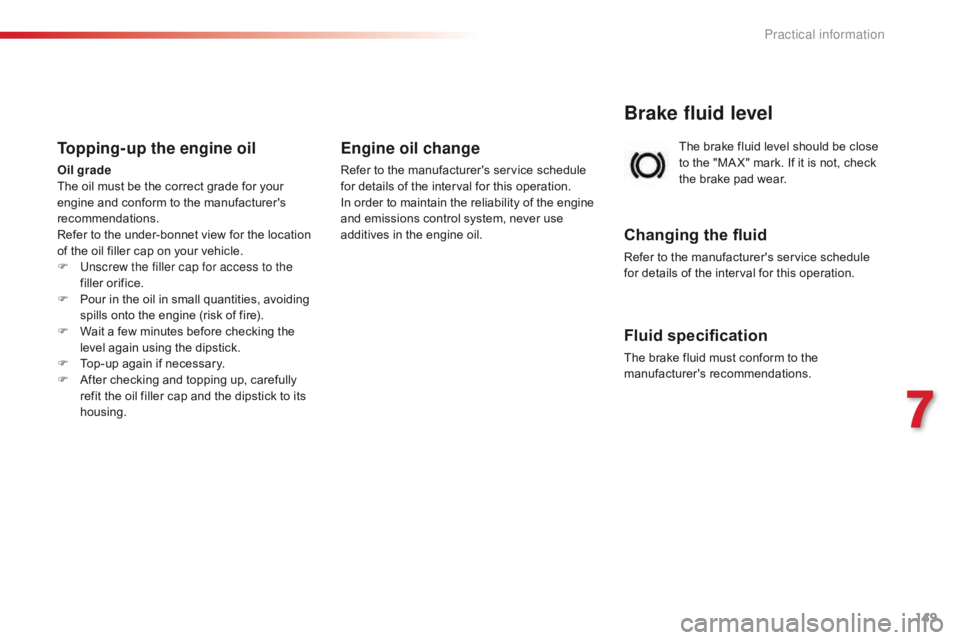
149
C1_en_Chap07_info-pratiques_ed01-2016
The brake fluid level should be close to  the  "MA X"  mark.  If  it  is  not,  check Â
t
he  brake  pad  wear.
Brake fluid level
Changing the fluid
Refer to the manufacturer's service schedule for  details  of  the  interval  for  this  operation.
Fluid specification
The brake fluid must conform to the manufacturer's r ecommendations.
Topping-up the engine oil
Oil grade
The oil  must  be  the  correct  grade  for  your Â
e
ngine  and  conform  to  the  manufacturer's Â
r
ecommendations.
Refer
 to  the  under-bonnet  view  for  the  location Â
o
f  the  oil  filler  cap  on  your  vehicle.
F
U
nscrew the filler cap for access to the
filler
 orifice.
F
Â
P
our  in  the  oil  in  small  quantities,  avoiding Â
s
pills  onto  the  engine  (risk  of  fire).
F
Â
W
ait  a  few  minutes  before  checking  the Â
l
evel  again  using  the  dipstick.
F
Â
T
op-up  again  if  necessary.
F
Â
A
fter  checking  and  topping  up,  carefully Â
r
efit  the  oil  filler  cap  and  the  dipstick  to  its Â
h
ousing.
Engine oil change
Refer to the manufacturer's service schedule for  details  of  the  interval  for  this  operation.
In
 order  to  maintain  the  reliability  of  the  engine Â
a
nd  emissions  control  system,  never  use Â
a
dditives  in  the  engine  oil.
7
Practical information
Page 153 of 269
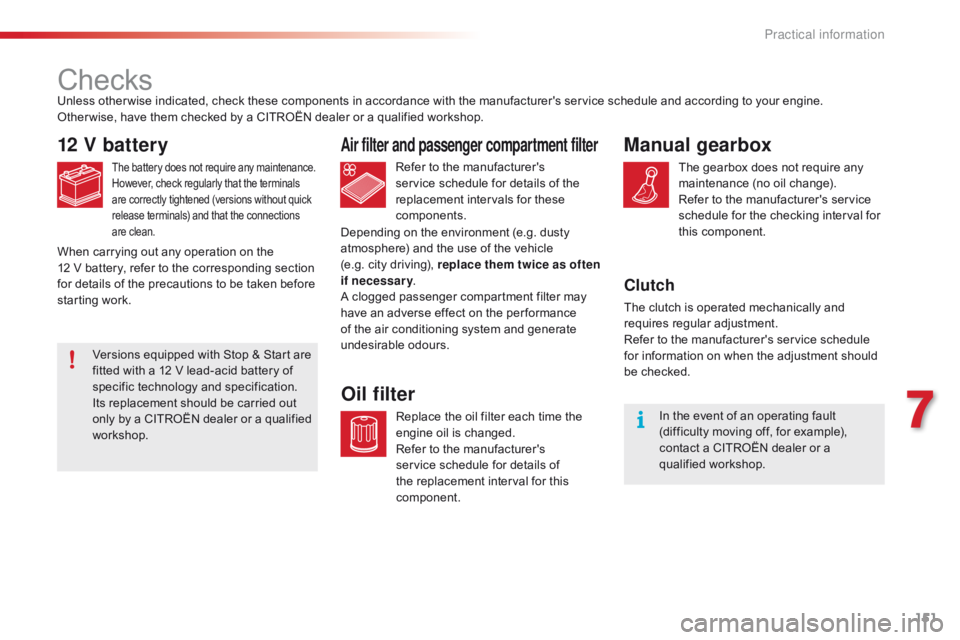
151
C1_en_Chap07_info-pratiques_ed01-2016
Checks
12 V battery
The battery does not require any maintenance.
H owever,  check  regularly  that  the  terminals a
re  correctly  tightened  (versions  without  quick
 r
elease  terminals)  and  that  the  connections
 a
re  clean.Refer to the manufacturer's service  schedule  for  details  of  the Â
r
eplacement  intervals  for  these Â
c
omponents.
Air filter and passenger compartment filter
Replace the oil filter each time the e ngine  oil  is  changed.
Refer
 to  the  manufacturer's Â
s
ervice  schedule  for  details  of Â
t
he  replacement  interval  for  this Â
c
omponent.
Oil filter
Unless other wise indicated, check these components in accordance with the manufacturer's service schedule and according to your engine.
O ther wise,  have  them  checked  by  a  CITROËN  dealer  or  a  qualified  workshop.
Depending
 on  the  environment  (e.g.  dusty Â
a
tmosphere)  and  the  use  of  the  vehicle Â
(e.g.
 city  driving),  replace them twice as often
if necessary .
A
 clogged  passenger  compartment  filter  may Â
h
ave  an  adverse  effect  on  the  per formance Â
o
f  the  air  conditioning  system  and  generate Â
u
ndesirable
 o
dours.
When
 carrying  out  any  operation  on  the Â
12
 V  battery,  refer  to  the  corresponding  section Â
f
or  details  of  the  precautions  to  be  taken  before Â
s
tarting  work.
Manual gearbox
The gearbox does not require any maintenance  (no  oil  change).
Refer
 to  the  manufacturer's  service Â
s
chedule  for  the  checking  interval  for Â
t
his
 c
omponent.
Clutch
The clutch is operated mechanically and requires r egular a djustment.
Refer
 to  the  manufacturer's  service  schedule Â
f
or  information  on  when  the  adjustment  should Â
be c
hecked.In
 the  event  of  an  operating  fault Â
(
difficulty  moving  off,  for  example), Â
c
ontact  a  CITROĂ‹N  dealer  or  a Â
q
ualified
 w
orkshop.
Versions
Â
equipped
Â
with
Â
Stop
Â
&
Â
Start
Â
are
Â
f
itted
Â
with
Â
a
Â
12
Â
V
Â
lead-acid
Â
battery
Â
of
Â
s
pecific
 t
echnology
 a
nd
 s
pecification.
Its
Â
replacement
Â
should
Â
be
Â
carried
Â
out
Â
o
nly
Â
by
Â
a
Â
CITROĂ‹N
Â
dealer
Â
or
Â
a
Â
qualified
 w
orkshop.
7
Practical information
Page 154 of 269
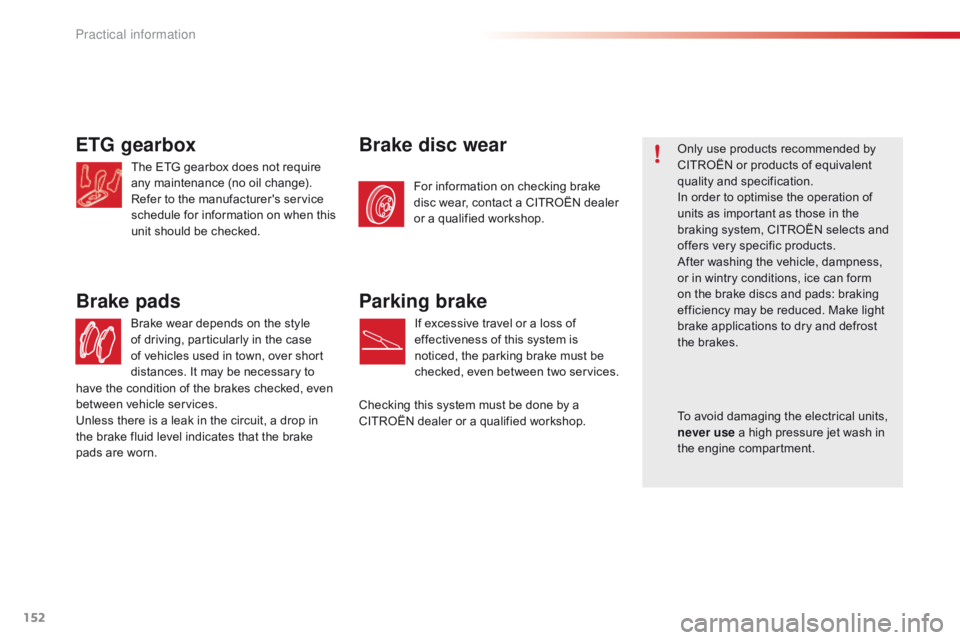
152
C1_en_Chap07_info-pratiques_ed01-2016
ETG gearbox
The ETG gearbox does not require any  maintenance  (no  oil  change).
Refer
 to  the  manufacturer's  service Â
s
chedule  for  information  on  when  this Â
u
nit  should  be  checked.
Brake
 wear  depends  on  the  style Â
o
f  driving,  particularly  in  the  case Â
o
f  vehicles  used  in  town,  over  short Â
d
istances.  It  may  be  necessary  to Â
Brake pads
For information on checking brake disc  wear,  contact  a  CITROĂ‹N  dealer Â
o
r  a  qualified  workshop.
Brake disc wearOnly use products recommended by CITROĂ‹N  or  products  of  equivalent Â
q
uality
 an
d
 sp
ecification.
In
 order  to  optimise  the  operation  of Â
u
nits  as  important  as  those  in  the Â
b
raking  system,  CITROĂ‹N  selects  and Â
o
ffers  very  specific  products.
After
 washing  the  vehicle,  dampness, Â
o
r  in  wintry  conditions,  ice  can  form Â
o
n  the  brake  discs  and  pads:  braking Â
e
fficiency  may  be  reduced.  Make  light Â
b
rake  applications  to  dry  and  defrost Â
t
he  brakes.
Parking brake
If excessive travel or a loss of effectiveness  of  this  system  is Â
n
oticed,  the  parking  brake  must  be Â
c
hecked,
 e
ven
 b
etween
 t
wo services.
Checking
Â
this  system  must  be  done  by  a Â
C
ITROĂ‹N
 dealer  or  a  qualified  workshop.
have
Â
the
Â
condition
Â
of
Â
the
Â
brakes
Â
checked,
Â
even
Â
b
etween
 v
ehicle
 s
ervices.
Unless
Â
there
Â
is
Â
a
Â
leak
Â
in
Â
the
Â
circuit,
Â
a
Â
drop
Â
in
Â
t
he
Â
brake
Â
fluid
Â
level
Â
indicates
Â
that
Â
the
Â
brake
Â
p
ads
Â
are
Â
worn. To
 avoid  damaging  the  electrical  units, Â
n
ever use  a  high  pressure  jet  wash  in Â
t
he  engine  compartment.
Practical information
Page 182 of 269
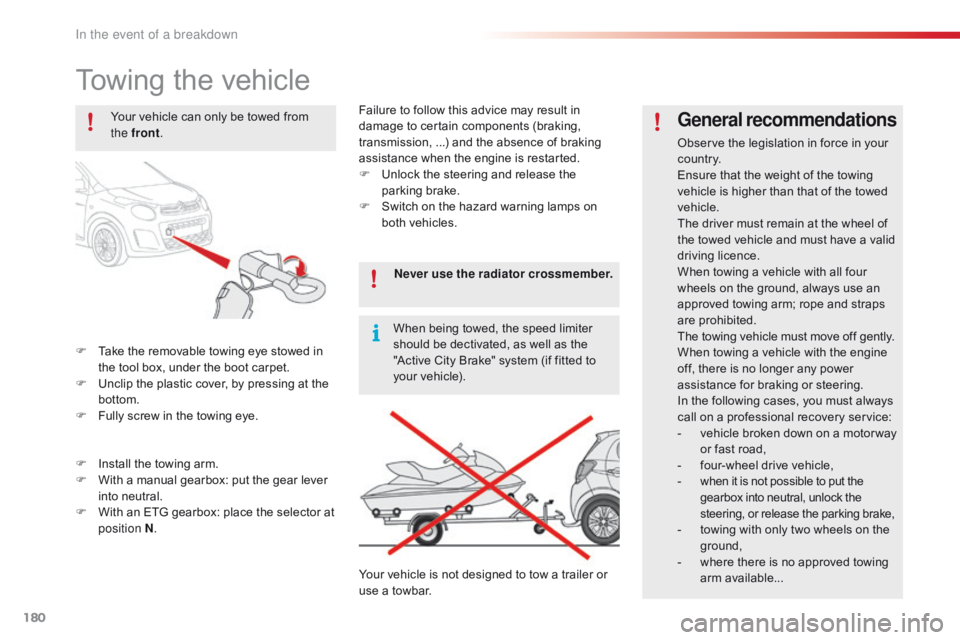
180
C1_en_Chap08_en-cas-pannes_ed01-2016
Towing the vehicle
F Take the  removable  towing  eye  stowed  in  t
he  tool  box,  under  the  boot  carpet.
F
Â
U
nclip  the  plastic  cover,  by  pressing  at  the Â
b
ottom.
F
Â
F
ully  screw  in  the  towing  eye.
General recommendations
Observe the legislation in force in your co unt r y.
Ensure
 that  the  weight  of  the  towing Â
v
ehicle  is  higher  than  that  of  the  towed Â
v
ehicle.
The
 driver  must  remain  at  the  wheel  of Â
t
he  towed  vehicle  and  must  have  a  valid Â
d
riving
 l
icence.
When
 towing  a  vehicle  with  all  four Â
w
heels  on  the  ground,  always  use  an Â
a
pproved  towing  arm;  rope  and  straps Â
ar
e
 p
rohibited.
The
 towing  vehicle  must  move  off  gently.
When
 towing  a  vehicle  with  the  engine Â
o
ff,  there  is  no  longer  any  power Â
a
ssistance  for  braking  or  steering.
In
 the  following  cases,  you  must  always Â
c
all  on  a  professional  recovery  service:
-
Â
v
ehicle  broken  down  on  a  motor way Â
o
r  fast  road,
-
Â
f
our-wheel  drive  vehicle,
-
 w
hen  it  is  not  possible  to  put  the
 g
earbox  into  neutral,  unlock  the
 s
teering,  or  release  the  parking  brake,
-
Â
t
owing  with  only  two  wheels  on  the Â
g
round,
-
Â
w
here  there  is  no  approved  towing Â
ar
m
 a
vailable...
Your
Â
vehicle
Â
can
Â
only
Â
be
Â
towed
Â
from
 t
he front
.
F
Â
I
nstall
Â
the
Â
towing
Â
arm.
F
Â
W
ith
Â
a
Â
manual
Â
gearbox:
Â
put
Â
the
Â
gear
Â
lever
Â
i
nto
Â
neutral.
F
Â
W
ith
Â
an
Â
ETG
Â
gearbox:
Â
place
Â
the
Â
selector
Â
at
Â
p
osition N . Never use the radiator crossmember.
When
Â
being
Â
towed,
Â
the
Â
speed
Â
limiter
Â
s
hould
Â
be
Â
dectivated,
Â
as
Â
well
Â
as
Â
the
Â
"
Active
Â
City
Â
Brake"
Â
system
Â
(if
Â
fitted
Â
to
Â
y
our
Â
vehicle).
Your
Â
vehicle
Â
is
Â
not
Â
designed
Â
to
Â
tow
Â
a
Â
trailer
Â
or
Â
u
se
Â
a
Â
towbar.
Failure
Â
to
Â
follow
Â
this
Â
advice
Â
may
Â
result
Â
in
Â
d
amage
Â
to
Â
certain
Â
components
Â
(braking,
 t
ransmission,
Â
...)
Â
and
Â
the
Â
absence
Â
of
Â
braking
 a
ssistance
Â
when
Â
the
Â
engine
Â
is
Â
restarted.
F
Â
U
nlock
Â
the
Â
steering
Â
and
Â
release
Â
the
Â
par
king
 b
rake.
F
Â
S
witch
Â
on
Â
the
Â
hazard
Â
warning
Â
lamps
Â
on
Â
b
oth
Â
vehicles.
In the event of a breakdown
Page 198 of 269
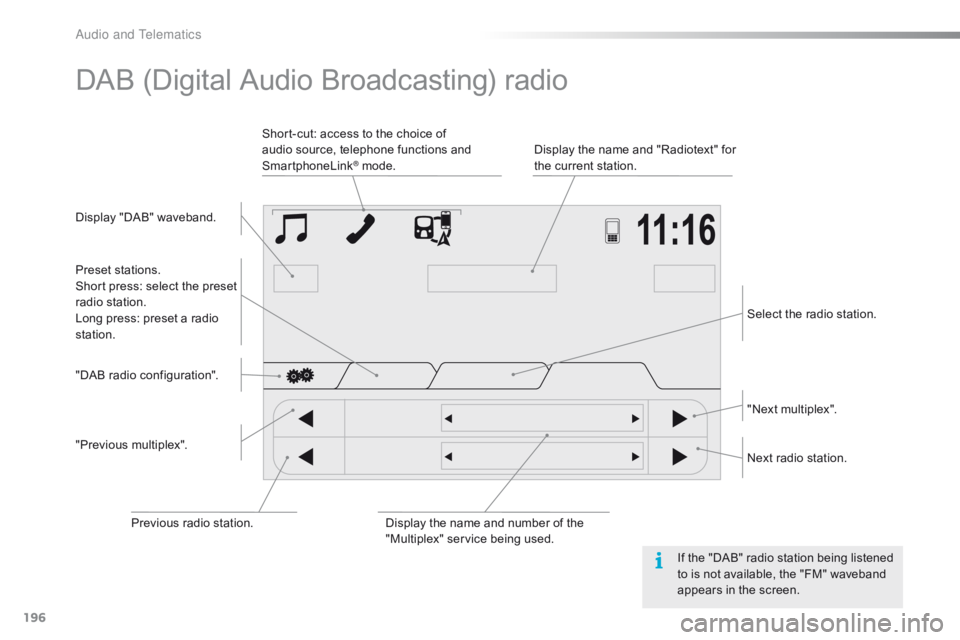
196
C1_en_Chap10a_ Autoradio-Toyota-tactile-1_ed01-2016
DAB (Digital Audio Broadcasting) radio
Display "DAB" waveband.D isplay  the  name  and  "Radiotext"  for Â
t
he  current  station.
Short-cut:  access  to  the  choice  of Â
a
udio  source,  telephone  functions  and Â
S
martphoneLink
® mode.
S elect  the  radio  station.
Preset
 s
tations.
Short
Â
press:
Â
select
Â
the
Â
preset
Â
r
adio
 s
tation.
Long
Â
press:
Â
preset
Â
a
Â
radio
Â
s
tation. "Next
 m
ultiplex".
Next
 radio  station.
Display
 the  name  and  number  of  the Â
"
Multiplex"  service  being  used.
"Previous
 m
ultiplex".
"DAB
Â
radio
Â
configuration".
Previous
Â
radio
Â
station. If
 the  "DAB"  radio  station  being  listened Â
t
o  is  not  available,  the  "FM"  waveband Â
a
ppears  in  the  screen.
Audio and Telematics